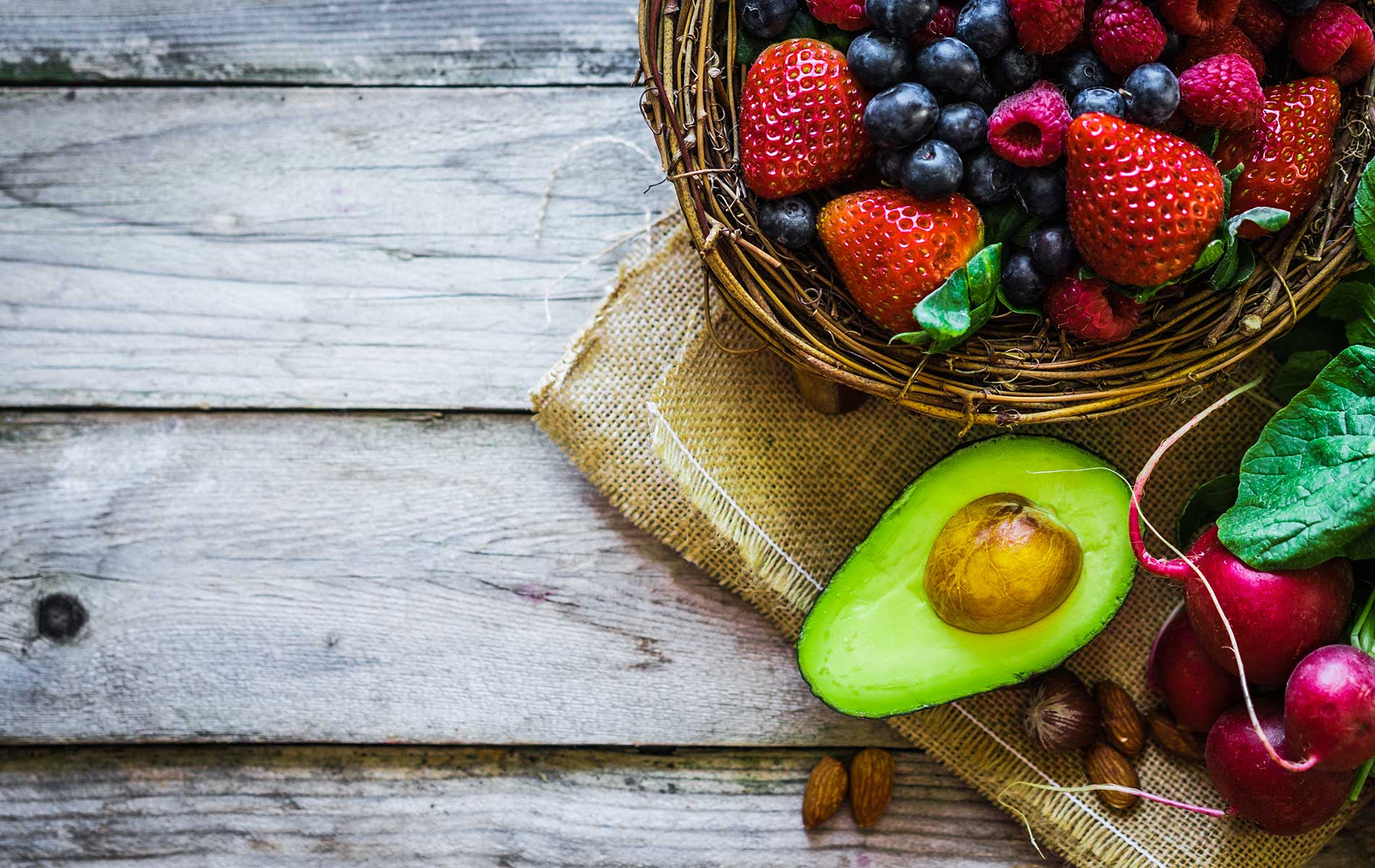
vie-magazine-health-nut
YOU ARE WHAT YOU EAT
(So don’t eat junk)
By Clark Peters
The title phrase is accurate … with some qualifiers. You are what you absorb from what you eat (or put less delicately, what you don’t excrete). It is critical for health (and longevity) to take in essential1 nutrients through the foods that you ingest. This has become increasingly difficult in the last forty years or so. Proper nutrition gets complicated very quickly, so full understanding may require reading several of my past and upcoming VIE articles. However, I promise that each article will contain some action steps that you can take to improve the quality of what you put in your mouth—the quantity (an important variable in healthy weight) is, of course, up to you.
The Basics
The body wants, needs, and, indeed, requires all three of the following macronutrients to thrive:
PROTEINS
CARBOHYDRATES
FATS
- Proteins: provide amino acids, the basic building blocks of all cells in muscles, organs, bones, connective tissue, etc.
- Carbohydrates (direct from nature): provide minerals, vitamins, fiber, and a host of phytonutrients required for system health.
- Fats: provide essential1 fatty acids that contribute cell wall material (lipids) and some cushioning and lubrication of joints.
The benefits contained in the “good” macronutrients (each category has good, bad, and ugly examples) are delivered to the body by first breaking them down (mouth and stomach acids, digestion, and bacteria in the intestines do the job) into glucose. Glucose, another word for blood sugar, is the body’s fuel and delivery system for the components of macronutrients. Ideally, our consumption of food would provide a steady, moderate supply of nutrient-bearing glucose to our cells throughout the day. (Hospitals achieve this with intravenous glucose drips.) So, the key to eating for good health (and weight control) is to spread out the supply of glucose as evenly as possible over the several hours between meals and snacks, bringing about a stable blood sugar level. This is where our modern diet causes problems!
The Glycemic Index and Glycemic Load2
You may be familiar with these terms—they get a lot of attention these days. Why? The glycemic index (GI) measures (on a scale from 1 to 100) how fast a particular food converts to glucose. The glycemic load (GL) measures how much glucose is delivered from a standard portion of a food.
So what? Well, it turns out that it matters a lot. One of our organs—the pancreas—is charged with keeping our blood sugar levels at a fairly narrow “moderate” range. Normally, it accomplishes this with very small squirts of insulin which converts available glucose to current energy needs, fuel for cells, and stores any small (hopefully) excess in fat cells. As time passes and blood sugar levels lower, glucose is released from fat cells to alleviate any shortfalls until the next meal/snack. With proper nutrition and reasonable portions at meals/snacks, this is how a healthy body processes good nutrition. The biochemical processes are much more complex in detail, but these are the basics.
So, what goes wrong? The problem arises from eating too much sugar (see the “Obesity” article in VIE – Summer 2010, page102) and highly refined (predigested) and, therefore, high glycemic foods. They are everywhere in modern American food offerings.
In general, carbohydrates have the higher glycemic indices (of course, sugar, in all its forms has the highest), proteins fall in the middle range, and fats are the slowest to convert to glucose. This is useful to know because combining a high GI food (say, an apple) with one containing protein or fat (say, peanut butter) tamps down the sugar rush from the high GI food eaten alone. The biggest problems, however, are the carbohydrates that do not come directly from nature (i.e., fruits and vegetables off the tree, bush, or from the ground). I am referring to the highly refined foods that comprise most of the supermarket foods these days, especially those made from refined grains (flour). They include:
- Cereals /granolas
- Pastries, muffins, scones, bagels
- Breads
- Pastas
- White rice products
- Crackers, chips, pretzels
- Waffles, pancakes
- Corn products
- Breakfast bars (even the so-called health or protein bars)
All of these should be viewed by the consumer as predigested sugar. Hopefully, you would not sit down at your kitchen table and consume a dozen mouthfuls of sucrose (table sugar). Yet, a large helping of any of the above is tantamount to doing just that! They all quickly turn into glucose by the time they hit your stomach. They are also, unfortunately, the major source of calories in the modern American diet.
Again, so what? Glucose is the body’s fuel. If a little is good, why isn’t a lot better? The answer contains the primary reason for obesity and many of the instances of fatal disease in America.
Eating food with a high GI, GL, or both floods the bloodstream with glucose. The brain, recognizing the sugar spike, sends an urgent message to the pancreas, which overreacts by shooting, not a squirt, but loads of insulin to deal with the excess. Since the body can absorb only so much glucose for its current needs (and a bit more stored in the liver for emergencies), the rest is packed into fat cells. Insulin is a powerful hormone that keeps fat cells open for hours when there is a great deal of this hormone around; this leads to a number of unfortunate side effects:
- Anything eaten for several hours goes to the fat cells that have remained open.
- The endocrine system (all of the hormones in your body) becomes severely imbalanced, which leads to inflammation. The medical science consensus now points to inflammation as the primary cause of all major degenerative diseases: heart disease, cancer, stroke, Alzheimer’s, and diabetes, and the list goes on.
- This much insulin empties the stomach very quickly, leaving us ravenous for more glucose to solve the emerging hypoglycemia (low blood sugar). Of course, the easiest way to obtain more glucose quickly is to consume the same kind of high GI foods which started the cycle, thus starting the cycle again.
Much of America goes through these sugar “highs” and “lows” all day, most days! This cycle rapidly packs on weight and eventually leads to insulin resistance—the first step toward type 2 diabetes. The hormonal swings lead to continual inflammation and disease. I trust that you will recognize that breaking out of this cycle is key to health, longevity, and weight management.
Clearly, the path to stable blood sugar involves eating reasonable portions of “good” macronutrients at every meal/snack. I keep using “meal/snack” because I am also suggesting that people should level their blood sugar by eating more frequently. Notice that I did not say more food—just more often. So, a method of spreading nutrition (and, therefore, glucose) over the waking hours would look like this:
- Breakfast
- Mid-morning snack
- Lunch
- Mid-afternoon snack
- Supper
- Mid-evening snack
Amounts would taper off as the day progressed. Thus, breakfast (breaking the mini “fast” of six to nine hours of sleep) can be a hearty meal. The idea of reducing quantities and calories from that point on reflects the activity level (and calories needed) for a typical day. By evening, you are “winding down,” and a huge supper followed by a big snack will not serve you well—either for weight control or sleep.
I will expand on “good” macronutrients in the Winter 2010 issue of VIE, but common sense may get you started. We are after “lean” protein (less than 20 percent fat), so all seafood, grass-fed beef, eggs, wild game, and low-fat dairy are good examples. Good carbs are those directly from nature—fresh or fresh-frozen fruits and vegetables. Fats are a little more complicated but should be part of most meals. Raw nuts, avocados, and unsaturated oils (e.g., olive oil) are a few examples of healthy fats—I will also touch on this more in the next issue.
Hopefully, these ideas will alter your food shopping for the future. I would be remiss, however, if I did not give you some “rules of the road” for the supermarket. These huge repositories of foodstuffs are virtual minefields without some savvy. The first rule is that you should shop the perimeter; this is where the real food is presented. The interior aisles contain all of the refined, processed stuff we’ve been talking about. Then you should know the translation for common marketing terms:
- Lean: Look for less than 20 percent fat. Lean doesn’t always get you there—extra lean normally will.
- Free: Meaningful if applied to unhealthful products such as sugar, trans fats, sodium, etc.
- Trans fats: The only acceptable words following are “zero, nada, zilch, none, free, etc.”
- Light, reduced, less: Means 25–33 percent fewer calories, fat, sugar—than the original! May not mean much if the original was loaded.
- High fiber: Always a good thing.
- Natural: Means absolutely nothing—every product started with something natural.
- Organic: Much more healthful and worth the premium cost.
- Low or no fat: This varies depending upon the food. Good if for meat, dairy, etc. If applied to packaged goods, it normally means huge additions of sugar to add flavor lost by removing fat.
- High Fructose Corn Syrup: Unacceptable. If mentioned in the ingredient list, put it back.
- Made with natural goodness, doctor recommended, parent tested, strengthens immune system, etc.: Oh, come on! Ignore all of these claims.
I know, it’s confusing out there. Hopefully, you are now more aware of how and why stable blood sugar is vital to health, and you understand a few ways to get through the grocery shopping minefield. Start removing the junk from your diet. Your body will be grateful, although it may mean spending a few dollars to buy smaller-sized clothing!
Notes:
- “Essential” is something the body must have and can’t make or combine from other materials, and, therefore, must be ingested—preferably daily.
- Any Internet search involving the use of “glycemic index” will bring up several sites with comprehensive GI listings.
— V —
Share This Story!
KEEP UP WITH THE LATEST STORIES FROM VIE

















































































































































